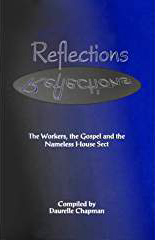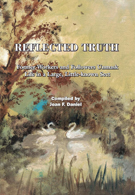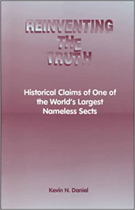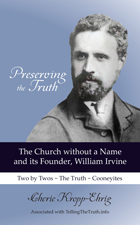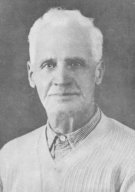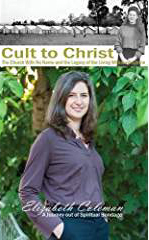Early History of the Work in England & Wales
When did the workers first arrive? Probably John Long in 1900 in Darlington, Co. Durham in NE England
Who were the first brother workers? In 1904: Willie Gill, Andy Robb and Wilson Reid, Jack Jackson, Wilson and Annie McClung, and others (Source: Willie Gill's Funeral notes). Possibly: Charles Ross, John Andrews, Tom & Ellen Elliott.
Who were the first sister workers? Alice Pipe, May Carroll, Annie Smith, Lizzie Sargent, and others
Who was the first to profess, what year and where?
Who were the first native workers to go in the work and When?
First Native Brother Worker:
First Native Sister Worker: Perhaps Alice Pipe? (from Wilby, Suffolk)
When & Where was the first Gospel Meeting?
When & Where was the first Sunday fellowship meeting?
When & Where was the first baptism?
When & Where was the first convention? Information needed
In 1909: Suffolk: Debenham, Stowmarket, owner Ernest Walter List;
In 1912, Conventions were held in England at
Lincolnshire: Thorpe-on-the-Hill, owner J. Scott; (perhaps there were more)
In 1913, Conventions were held in England at
Lancashire: Sunnybrow, Coppull, Chorley, owner R. Woodcock;
Somerset: Goodedge Farm, North Brewham, Bruton, owner Joseph Burfitt.
Where have subsequent conventions been held? In 1916: Sunnybrow, Coppull, Chorley, Lancashire, owner R. Woodcock; Debenham, Stowmarket, Suffolk, owner Ernest Walter List;
Goodedge Farm, North Brewham, Bruton, Somerset, owner Joseph Burfitt; Spilsby, Lincolnshire; West Hanney, Berkshire--began in 1915)
WALES: Convention held at Dolwilkin Farm, Knighton, Radnorshire, Wales.
Wales has never had a separate staff of workers; usually two pairs attached to England.
Where are the conventions now held in 2016? Uttoxeter in Staffordshire; Preston in Lancashire; and two weekends at Yorkley, Gloucester, near the Forest of Dean on the borders of Wales.
Who have the Overseers been? Willie Gill (died June 5, 1951),
Jack Forbes enterd the work in 1907, was born March 8, 1886 in Co. Meath, Ireland, died August 25, 1975 in England, buried in Newbury, Berkshire.
Percy Fletcher, Norman Henderson (died 1992), Ken Paginton, Dennis Fenton & Ben Crompton together; Ben Crompton assisted by David Delaney from Ireland (2016).
1905 Workers List - Workers born in England: Adam Hutchison, Harry Oliver, Hampshire, England; Alice Pipe, Wilby, Suffolk;
TTT Editor's Note: In the absence of a written account, the above information has been compiled by the TTT Editor from various sources. Corrections or additions are most welcome; as well as other historical accounts for this country Email TTT
 The West Hanney Convention Story
The West Hanney Convention Story
Oxfordshire, England
Author unknown
May 25, 1988
The West Hanney Story
This morning I had a privilege here at Oxfordshire convention grounds that came very unexpectedly. Life is full of such unexpected privileges and when I think of how easily I could have missed this one it makes me wonder how many times I have missed a privilege that was at my doorstep.
This one came my way because of stopping to ask a brother if he would like to go for a walk with me. It was Peter Hingely with whom I walked and as we walked through the streets of West Hanney he told me the story of how the gospel came to this village and showed me the spot where the mission was worked and the place where later a convention was held from 1915 until 1934. I shall try to relate parts of that story here.
In 1904 several workers came over from Ireland to bring the gospel of truth to England. Among them was Willie Gill and he was moved to come to this area that year. I should mention that the Oxfordshire convention is so named because the closest large centre is Oxfordshire. The convention is, in fact, situated in the little village of West Hanney and this is the location that this story is centred around. He made enquiries about getting a place for meetings but was told there was no place so moved on to the neighbouring area.
About the same time there was, in the village, a Mr Willis who was religious and concerned that the village should have a public prayer hall where religious meetings could be held. He sold the idea to the community and took up a collection and built a small brick building that became known as the mission hall. After completing the hall he tried to get local pastors interested in having meetings there but no one would come without being paid to do so.
It came to Mr Willis’ ears that Willie Gill had been enquiring about a hall some time before and had moved on to another place. He sent for him and Willie and companion were only too glad to come. He had a grand mission there and eventually many in the village made their choice including Mr Willis and his family.
There was a group of women in the village who were having prayer meetings together and they had been praying that God would send them help and several of them made a start in that mission as well. There was great opposition to the meetings.
Willie Gill baptised those who made their choice in a water trough inside the brick mission hall. After being baptised they had to walk down the street to a friend’s home nearby to change into dry clothes and a crowd was waiting outside the hall to jeer at them as they came out.
The little brick hall belonged to the community because it was built with community funds but was used solely by the friends and workers thereafter. It was demolished just two years ago and Peter took me by the spot where it had stood and showed me the house where those early friends had gone to change after their baptism.
Nearby is a set of buildings where the first convention in 1915 was held. They had thought to use the mission hall for the convention meetings but so many people came for that first convention that they had to quickly find a tent and erect it in a vacant lot near by. The local lumber merchant let them have planks for benches every year free of charge on the condition they would be returned without having nails driven into them.
I saw the vacant lot where the tent stood and the house where visiting workers were housed for the convention in those years. One of the main buildings, I understand, was thatched roof house belonging to one of the friends. They used to do the cooking outside near this house and one year the roof caught fire and the house burned down.
Willie Gill was staying in that house but was away at the time and when he rushed back he found the lady of the house standing and watching her house burn down. Beside her was Willie’s suitcase, the only thing that she had salvaged form the burning building. It was after that that the convention was moved to the present site and it has been held here ever since.
The story in itself is interesting but to walk through the village and see the places as the story unfolded was an experience I will never forget. Someone asked me yesterday if the name Willie Gill meant anything to me and I answered that I had heard that name but it had no particular significance to me.
He is buried just up the street in the local church yard along with his sister, Emma, and Sarah Humphries, who were also in the work. Over 20 friends are buried there also. This morning, if anyone were to ask that same question my answer would be so very different. And it is all because of the decision I made this morning to go for that walk with Peter and his graphic description of what has taken place almost 100 years ago.
NOTE: As told by Peter Hingeley to another person.
TTT NOTES:
The village of West Hanney, Co. Oxfordshire, England is the location of this convention.
Formerly, it was located in Berkshire, but the boundaries were changed.
Originally the town was simply known as Hanney. In 1974 the village split into East Hanney and West Hanney.
Some casual names for this convention are: Berks, Berkshire, Oxon, Oxford, Oxfordshire, Hanney and West Hanney.
In correct geographical terms, the convention is held in the village of West Hanney, which is located in the county of Oxfordshire. (NOT Oxford…Oxford is the name of a city).
Reportedly, there is a statue of Walter Hanney next to the old village post office.
Any information relative to the early workers, missions, conventions in England are welcome. Email TTT

 REPRESENTING THE LARGEST COLLECTION OF 2X2 HISTORICAL DOCUMENTS ON THE INTERNET
REPRESENTING THE LARGEST COLLECTION OF 2X2 HISTORICAL DOCUMENTS ON THE INTERNET
 Perry, Oklahoma Conv, 1942
Perry, Oklahoma Conv, 1942
